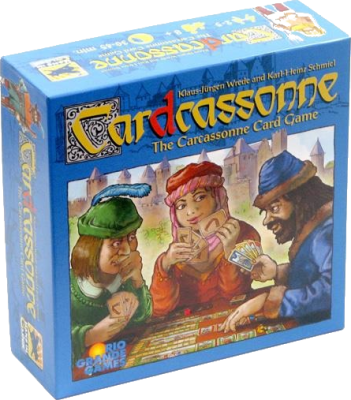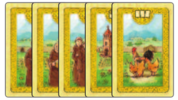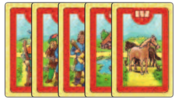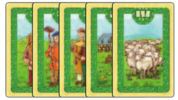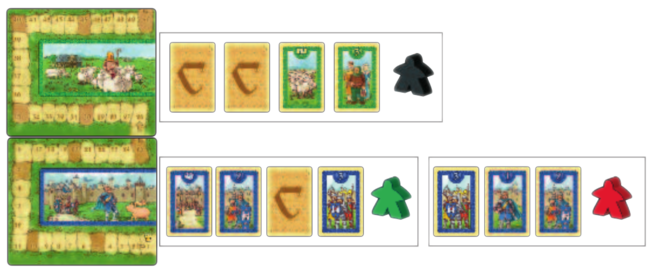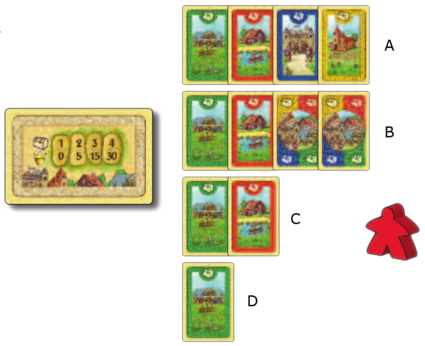Cardcassonne
General info and comments
Cardcassonne is the official card game of Carcassonne, it was designed by Klaus-Jürgen Wrede and Karl-Heinz Schmiel, illustrated by Claus Stephan, and released in 2009.
Contents
- 4 Scoring tracks in 4 colors (yellow, red, green, blue)
- They form a winding scoring track from 1 to 100.
|
|
 |
|
|
|
 |

|
- 140 cards
- 30 cards per color consisting of:
- Jokers: 2 (dragon and fairy)
- 4 animals
- 4 buildings
- 5 scoring cards





Points for animal cards
Points for city cards
- 1 rule booklet
- 5 blank cards (not used in the game)
Rules
Overview and goal
By skillful placing of cards and protecting card series’, the players earn points.
At game's end, the player with the most points wins the game.
Preparation
Place the 4 scoring tracks at the end of the table, one above the other, as shown below, to form a continuous scoring track from 1 to 100. They should be placed so their “open” sides face the table where players will play their cards.
The players will place cards next to these open sides such the card colors match the opening colors.
- 1 large follower in his color

- 1 small follower in his color which he places next to the 1 on the scoring track

- 1 chest

- 1 scoring card

With fewer than 5 players, place unused scoring cards, chests, and followers back into the box along with the blank cards.
The players choose one player to be the dealer.
Shuffle the remaining 130 cards several times and place them on the table as a supply. Subsequently, the dealer draws the top-most card and places it next to the opening matching its color. He continues in this way until he has placed 10 cards. If he draws a joker, he places it in the row of his choosing.
The dealer now gives each player cards from the supply, depending on the number of players. This is also done at the beginning of each round:
| # of players | cards per round | # of rounds |
|---|---|---|
| 2 players | 6 cards | 10 rounds |
| 3 players | 5 cards | 8 rounds |
| 4 players | 5 cards | 6 rounds |
| 5 players | 4 cards | 6 rounds |
Each player takes the cards and holds them secretly in his hand.
Playing the game
Round start
Cardcassonne is played over several rounds. Each round begins with the player to the left of the dealer and continues clockwise around the table. A round ends when all players have placed all their hand cards, have placed their large followers, and have executed the scoring. Each player, on his turn, must choose to execute one of the following two actions, either:
■ Place one card or
■ Place his large follower.
Place one card
The player places one of his hand cards at the beginning of an empty row or next to the last card previously placed on a non-empty row. The player follows these rules:
- He must place his first card in each round face down.
- He must place each further card in the round face up.
- He must place the card in the row that matches the color of the card (except for face-down cards, see mismatched rules section).
- He may place a joker (animal joker, building joker, dragon, or fairy) on any row.
- He may never place a card between cards already placed.
Place his large follower
The player places his larger follower at the end of a row. With it the player claims the cards behind it in the row for himself. The claim is only for the cards from the follower to the scoring track or another large follower, whichever comes first.
Follow these rules also:
- Once placed, the follower remains until the next round-end scoring.
- Several followers may be placed in a single row.
- The player who is the last to place his follower laying-down [1] in a round becomes the dealer for the next round.
- The player gets the cards he claims with his follower at the round-end scoring.
Once a player has executed one of the two actions, his turn is over and the next player takes his turn.
Scoring the cards
When all players have played all their hand cards and placed their large followers, each player takes the cards he has claimed with his large follower and takes back his large follower. Each then scores by moving his small follower along the scoring track. When a player passes 100, he takes a 100 tile, and will turn it one to 200 if he passes 200 points.
The claimed cards are taken (from the rows from bottom to top). Cards not claimed remain in their rows and should be moved close to the scoring track if cards between them and the track are taken. Face-down claimed cards are turned face up. Cards claimed by players are scored as follows by the players.
 Person cards (1-3)
Person cards (1-3)
Multiply the sum of the values of the numbers on the cards by the number of cards to get the person card score. The player records the score by moving his small follower along the scoring track. The player returns the scored cards to the box.
 Animal cards
Animal cards
Players who have claimed animal cards group them by animal type and score them as described in the example below:
| ① Red has 2 sheep cards among his claimed cards. He puts them face up in his play area and records the 6 points on the scoring track. The animal cards remain in his play area. |
If the player claims animal joker card(s) without any animal cards in his play area, he scores 3 points for each. As soon as he claims animal cards, he must allocate the animal joker card(s) to one kind of animal card. If a player has animal cards in his play area, but does not add to that animal type in a round, he does not score that type this round.
 Building cards
Building cards
Players who claim building cards put them face down under their chests. These cards are scored at game end. The players may not look at the cards under their treasure chests during the game. Building jokers are also placed under the treasure chests and scored at game end.
 Joker
Joker
The dragon and fairy cards immediately score 10 points each, which the player records on the scoring track. These cards are then returned to the box.
Color mismatched cards
Only possible with cards placed face down
If a player claims a face down card that does not match the color of the row it is in, it is handled in the following manner:
For each person card claimed in a false color, the player immediately records 10 points on the scoring track and returns the card to the box.
For each animal or building card claimed in a false color there are two possibilities:
- He immediately records 10 points on the scoring track and returns the card to the box, or
- He places the animal card in his play area and scores points accordingly;
He places the building card under his chest.
Round end
The (new) dealer deals each player new cards according to the table above and the next round begins.
Game end
The game ends immediately when the card supply is exhausted. Any cards that remain unclaimed are returned to the box.
Final scoring
The players score their building cards. Each player takes the cards he claimed during the game from under his chest.
Players score for each group of 2 to 4 different building cards.
Thus, the players score the following points:
- 1 single building card 0 points
- 2 different building cards 5 points
- 3 different building cards 15 points
- 4 different building cards 30 points
The building joker can be used for each building card.
Players record their building card scores on the scoring track.
The player with most points wins the game.
If players tie with the most points, the player among those tied with the most building cards is the winner.
Accessories
Footnotes
For Icons explanation and licensing please visit Icons page.
- CategoryCategory: CategoryCategory: CategoryCategory: CategoryCategory: CategoryCategory: CategoryCategory: CategoryCategory: CategoryCategory: CategoryCategory: CategoryCategory: CategoryCategory: CategoryCategory: CategoryCategory: CategoryCategory: CategoryCategory: CategoryCategory: CategoryCategory: CategoryCategory: CategoryCategory: CategoryCategory: Category:Spinoff
- CategoryCategory: CategoryCategory: CategoryCategory: CategoryCategory: CategoryCategory: CategoryCategory: CategoryCategory: CategoryCategory: CategoryCategory: CategoryCategory: CategoryCategory: CategoryCategory: CategoryCategory: Category: Category:Cardcassonne
